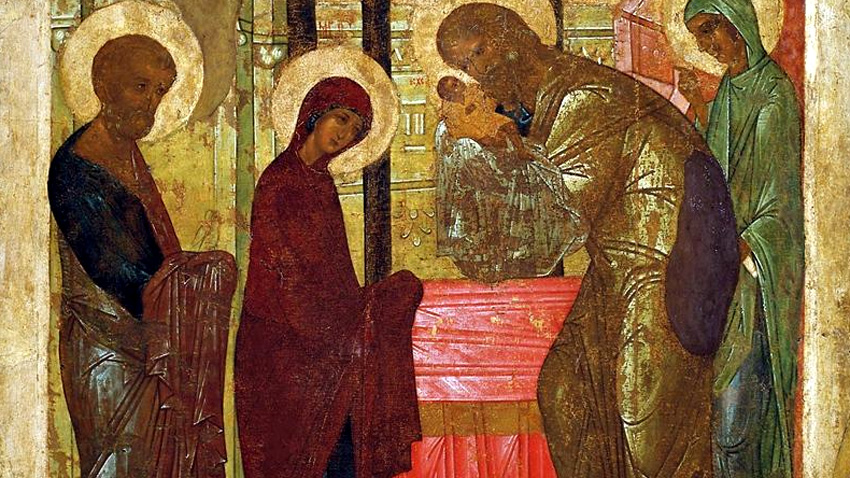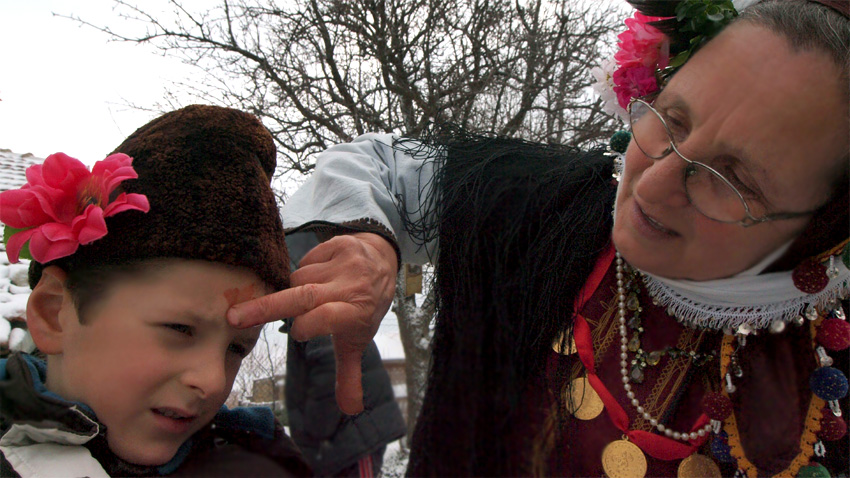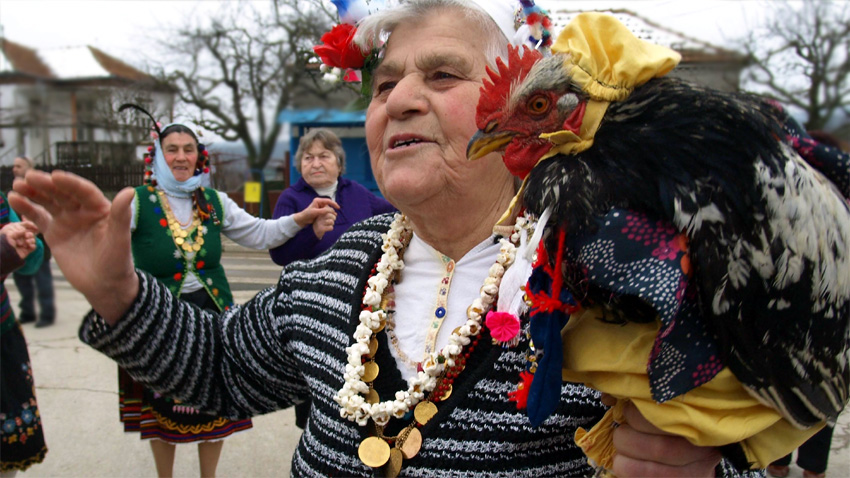As most Christian feast days, the presentation of Jesus Christ in the temple or Candlemas (2 February) has its ancient folklore equivalent whose roots lie buried in the mists of pagan times. Besides Candlemas, it also goes by the name of second Trifunets (or second Trifon Zarezan, Trifon the Pruner), rooster day etc.
 Candlemas is one of four principal dates in the calendar devoted to the Holy Mother of God. Every year the feast commemorates an early episode in the life of Christ – when Mary and Joseph took the infant Jesus to the Temple in Jerusalem forty days after his birth in obedience to the laws of Moses which stipulate that the firstborn son should be consecrated to God. The symbolic price of redemption was a lamb. For those who could not afford a lamb, the option was to sacrifice “a pair of turtledoves, or two young pigeons.” To complete Mary's ritual purification after childbirth, Mary and Joseph took the infant Jesus to the temple and sacrificed two turtledoves. According to legend, there they encountered Simeon “a man righteous and devout”. Simeon had been promised that he should not see death before he had seen the Messiah. Simeon then took the infant Jesus in his arms and uttered a prayer which prophesied the redemption of the world by Jesus.
Candlemas is one of four principal dates in the calendar devoted to the Holy Mother of God. Every year the feast commemorates an early episode in the life of Christ – when Mary and Joseph took the infant Jesus to the Temple in Jerusalem forty days after his birth in obedience to the laws of Moses which stipulate that the firstborn son should be consecrated to God. The symbolic price of redemption was a lamb. For those who could not afford a lamb, the option was to sacrifice “a pair of turtledoves, or two young pigeons.” To complete Mary's ritual purification after childbirth, Mary and Joseph took the infant Jesus to the temple and sacrificed two turtledoves. According to legend, there they encountered Simeon “a man righteous and devout”. Simeon had been promised that he should not see death before he had seen the Messiah. Simeon then took the infant Jesus in his arms and uttered a prayer which prophesied the redemption of the world by Jesus.
In folklore tradition the three days – 1, 2 and 3 February - go by the name of Trifuntsi – after St. Trifon, honoured by the church on 1 February. The Second Trifunets is also called Candlemas, as it is known in the Christian Orthodox calendar. The third is Semen or Simon (Simeon) – named after the old man Mary and Joseph encountered in the temple. On this day, 2 February, women would bake loaves of bread to give to two households. According to popular belief, if you are given money on this day, you shall receive money throughout the year. If you give money – you shall be giving money all the year. If the weather is clement, it shall remain clement 40 more days. If it snows in large flakes then the bees shall swarm well in summer. The day is seen as the equivalent of St. Ignatius day – it is said that whatever (whoever) one shall meet upon leaving the house, that shall be his luck throughout the year.
The name Petlyovden or Petelarovden (Rooster day) is more of a regional feast day spread across Eastern Bulgaria. 2 February, old style is when the memory of St. Euthymius of Turnovo is honoured. That is the reason why in some parts this day is also known as Evtimovden, Evtimya, Ihtima… But it has nothing to do with the church calendar. Experts say Rooster Day has its roots in early Slavic tradition. The rooster has a close bond with the sun, in fact it is one of the sun symbols, heralding the coming of a new day. It also symbolizes virility and fertility. The rituals on this day aim to evoke health and fecundity in boys, and sacrificing a rooster is obligatory. The sacrifice should be performed by women, mothers of male offspring, or by a boy who has not reached sexual maturity. In some parts the sacrificial rooster is black. The mother or the boy perform the sacrifice on the gate threshold and then make the sign of the cross in blood on the face of the boys and on the doors of the house. The rooster would be boiled and then given out to neighbours, along with pieces of the bread.

Colourful and imbued with a deep symbolical meaning, the rituals performed on Rooster Day are reminiscent of the obligatory practices on Babinden (Granny or midwives day), 21 January, like the visit to the midwife who helped bring the children into this world. In practically all parts of the country a table is laid out in the house of the granny (midwife) and the meal is accompanied by much mirth and bawdy comments. Unlike Babinden when women would wear their best clothes, on Rooster Day they would all put on their wedding attire, including the “granny” with a special addition – rooster feathers, taken from its tail; the “granny” would also be adorned with tufts of wool, strings of popcorn and red peppers – all of them symbols of fertility. The “granny” would thurify the food on the table and bless the women – again a complete replica of Babinden tradition. In our day the rituals are only performed in villages as a reenactment. But there is one aspect of the tradition that is observed in many parts – the festive meal and merrymaking.

English version: Milena Daynova
According to popular belief, the color red has the power of the sun and gives vitality to every living being, while white symbolizes purity, innocence and joy . The appearance of the twisted white and red threads, known as martenitsa, means that winter..
The Philip Koutev National School of Folk Arts is not just any school - it is a talent laboratory. It is the first school not only in Bulgaria but in the Balkans for professional study of folklore. It is located in the heart of the beautiful town of..
Scientists from the Sorbonne will study the cultural heritage preserved in the Regional Ethnographic Open-Air Museum "Etar" , informs public broadcaster BNT. In March this year the French scientists together with experts of REOM "Etar" will study elements..

+359 2 9336 661
